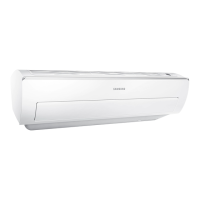Do you have a question about the Samsung AR18HSFSJWKX and is the answer not in the manual?
Key symbols and precautions for safe operation and installation.
Warning about chemicals known to cause cancer and reproductive toxicity.
Specifies temperature and humidity ranges for efficient air conditioner operation.
Explains unit protections and the Smart Install function for installation checks.
Identifies the primary physical components of the indoor air conditioner unit.
Describes the indicators and display elements on the remote controller or indoor unit.
Explains the function of each button on the remote control for operating the air conditioner.
Details the indicators and symbols shown on the remote controller's display screen.
Covers low battery warnings, storage, and battery insertion for the remote controller.
Explains the operation of Auto, Cool, Dry, Fan, and Heat modes of the air conditioner.
Guides on adjusting the vertical and horizontal air flow blades for optimal air distribution.
Guides on setting the timer for the air conditioner to turn on automatically.
Guides on setting the timer for the air conditioner to turn off automatically.
Explains how to set both On and Off timers for sequential operation.
Details the 3-stage operation for comfortable sleep, adjusting temp & fan speed.
Sets AC to cool quickly, then switch to Dry mode when target temp is reached.
Enables rapid and powerful cooling or heating by maximizing air output.
Provides mild cooling or heating by spreading air indirectly for comfort.
Reduces energy usage by operating at a lower capacity, suitable for one person.
Reduces operating noise from the indoor unit for a quieter environment.
Produces positive ions to improve air quality by supplying them into the airflow.
Minimizes indoor unit moisture to provide cleaner air after operation stops.
Allows muting of the beep sound emitted from the indoor unit.
Displays the amount of electricity consumed by the air conditioner during operation.
Resets the reminder indicator after cleaning the air conditioner's filter.
Allows adjustment of the display lighting, including turning it off.
Guides on connecting the air conditioner to a smartphone app for remote control.
Instructions for cleaning the interior components of the air conditioner.
Steps to clean the heat exchanger of the outdoor unit to maintain performance.
Step-by-step guide on how to remove the air filter from the indoor unit for cleaning.
Instructions for cleaning the air filter using vacuum or washing.
Steps to reinstall the air filter back into the indoor unit after cleaning.
Provides a chart for regular checks and cleaning of indoor and outdoor units.
Solutions for unit not working, or problems with temperature adjustment.
Solutions for issues with cool/warm air output and air flow adjustment.
Troubleshooting for unresponsive remote controllers and timer function problems.
Addresses blinking indicators, errors, odors, noise, and water dripping issues.
General safety guidelines for handling, installation, and usage of the air conditioner.
Guidelines for selecting an appropriate location for the indoor unit for optimal performance.
Safety checks and requirements for the power supply connection.
Guidelines for selecting an appropriate location for the outdoor unit to ensure proper operation.
Specifies required clearances around the outdoor unit for proper airflow and installation.
Lists and describes accessories supplied with the indoor unit.
Lists and describes accessories supplied with the outdoor unit.
Lists optional accessories and general tools required for installation.
Step-by-step guide on how to fix the installation plate to the wall or frame.
Steps to disassemble and reassemble the indoor unit's cover panel for installation.
Details cable specifications and guides for electrical wiring connections.
Procedures for connecting refrigerant pipes to the indoor unit, including torque specifications.
Instructions on how to cut and flare refrigerant pipes correctly for installation.
Guides on routing and connecting the drain hose from the indoor unit to ensure proper drainage.
Instructions for changing the direction of the drain hose connection if necessary.
Steps for connecting the drain hose to the outdoor unit and ensuring proper drainage.
Procedure for removing air from refrigerant pipes using a vacuum pump.
Guides on manifold gauge use and adding refrigerant based on pipe length.
Method for charging refrigerant using a liquid pipe, with cylinder orientation guidance.
Procedures for leak testing with nitrogen/refrigerant and pump down.
Final steps for installing the indoor unit onto the mounting plate.
Guidelines for installing the outdoor unit level on a stable base.
Steps to initiate and run the Smart Install mode for installation verification.
Explains progress indicators and error codes during Smart Install mode.
Checklist of items to verify before starting trial operation and steps for the trial run.
Procedure for collecting refrigerant before removing the unit from service.
Detailed instructions for extending the power wiring using connection sleeves and heat shrink tubes.
Steps for installing an optional Sub PCB for enhanced functionality.
Lists parts and guides wiring for the optional wired remote controller.
| Type | Split Air Conditioner |
|---|---|
| Cooling Capacity | 1.5 Ton |
| Refrigerant | R410A |
| Outdoor Noise Level | 52 dB |
| Operating Voltage | 220-240 V |
| Operating Frequency | 50 Hz |
| Air Flow (Indoor) | 600 m³/h |
| Power Supply | 220-240V |











